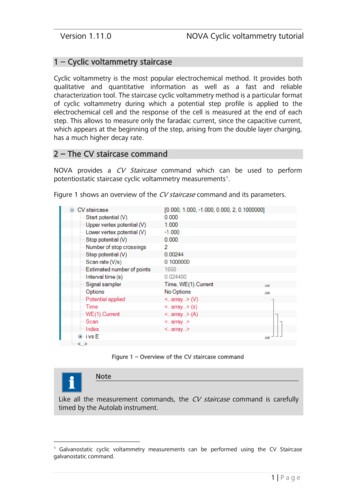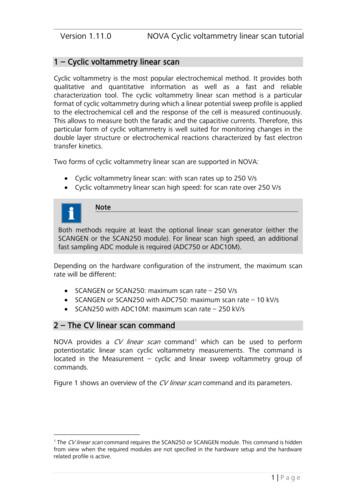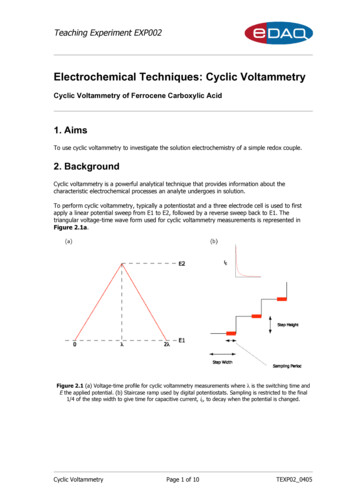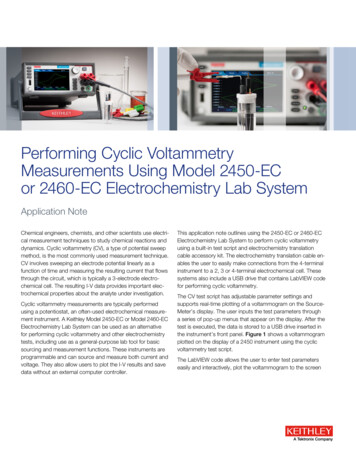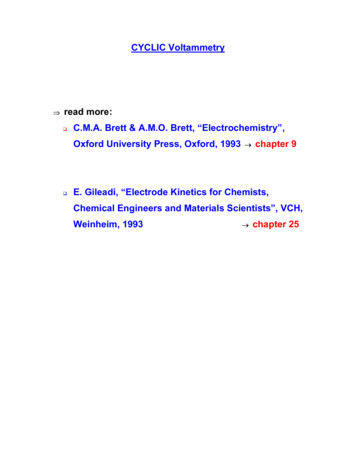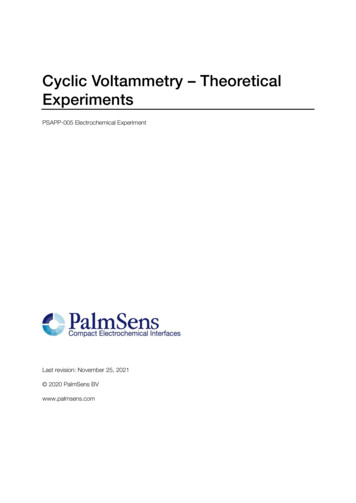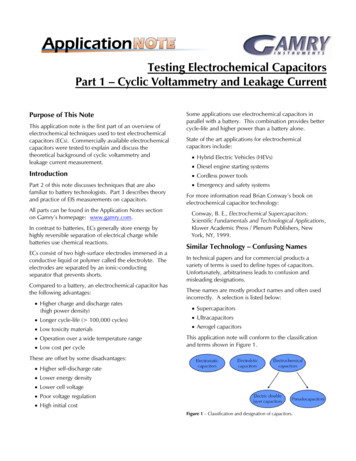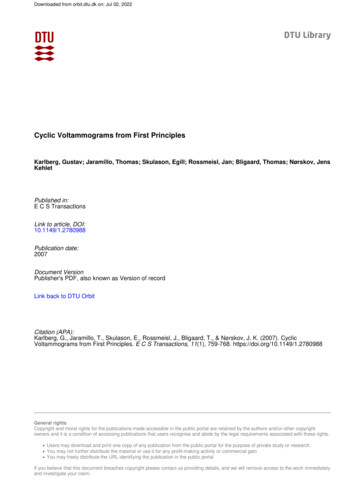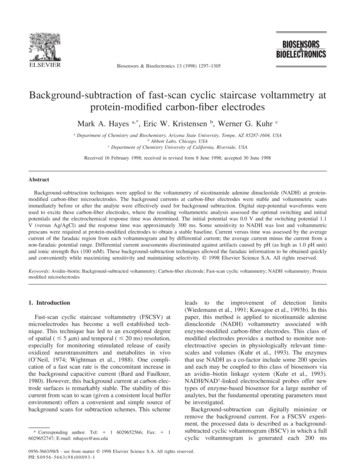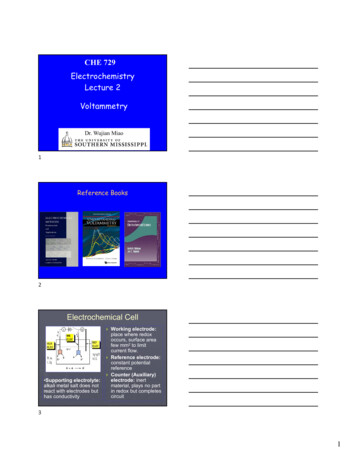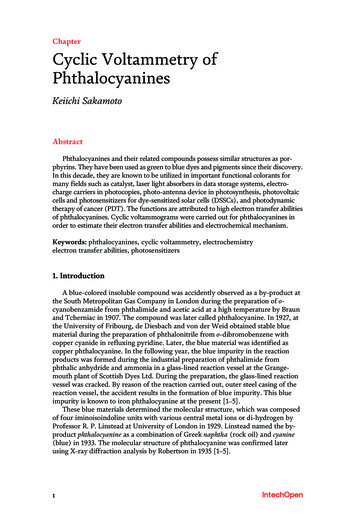
Transcription
ChapterCyclic Voltammetry ofPhthalocyaninesKeiichi SakamotoAbstractPhthalocyanines and their related compounds possess similar structures as porphyrins. They have been used as green to blue dyes and pigments since their discovery.In this decade, they are known to be utilized in important functional colorants formany fields such as catalyst, laser light absorbers in data storage systems, electrocharge carriers in photocopies, photo-antenna device in photosynthesis, photovoltaiccells and photosensitizers for dye-sensitized solar cells (DSSCs), and photodynamictherapy of cancer (PDT). The functions are attributed to high electron transfer abilitiesof phthalocyanines. Cyclic voltammograms were carried out for phthalocyanines inorder to estimate their electron transfer abilities and electrochemical mechanism.Keywords: phthalocyanines, cyclic voltammetry, electrochemistryelectron transfer abilities, photosensitizers1. IntroductionA blue-colored insoluble compound was accidently observed as a by-product atthe South Metropolitan Gas Company in London during the preparation of ocyanobenzamide from phthalimide and acetic acid at a high temperature by Braunand Tcherniac in 1907. The compound was later called phthalocyanine. In 1927, atthe University of Fribourg, de Diesbach and von der Weid obtained stable bluematerial during the preparation of phthalonitrile from o-dibromobenzene withcopper cyanide in refluxing pyridine. Later, the blue material was identified ascopper phthalocyanine. In the following year, the blue impurity in the reactionproducts was formed during the industrial preparation of phthalimide fromphthalic anhydride and ammonia in a glass-lined reaction vessel at the Grangemouth plant of Scottish Dyes Ltd. During the preparation, the glass-lined reactionvessel was cracked. By reason of the reaction carried out, outer steel casing of thereaction vessel, the accident results in the formation of blue impurity. This blueimpurity is known to iron phthalocyanine at the present [1–5].These blue materials determined the molecular structure, which was composedof four iminoisoindoline units with various central metal ions or di-hydrogen byProfessor R. P. Linstead at University of London in 1929. Linstead named the byproduct phthalocyanine as a combination of Greek naphtha (rock oil) and cyanine(blue) in 1933. The molecular structure of phthalocyanine was confirmed laterusing X-ray diffraction analysis by Robertson in 1935 [1–5].1
VoltammetryPhthalocyanine and metal containing phthalocyanines have been established asblue to green dyestuffs and pigments. Phthalocyanines and metal phthalocyaninesare using an important industrial commodity since 1942 [1–5].Phthalocyanines are an analogous molecular structure as natural colorant of porphyrins. In general, porphyrins consist of four pyrrole units, while phthalocyaninesconstruct four isoindole and nitrogen atoms at meso positions. The central cavity ofphthalocyanines can place 63 different elemental ions including di-hydrogen (metalfree phthalocyanine). Phthalocyanines containing one or two metal ions are calledmetal phthalocyanines. In phthalocyanine ring system and part of the atom numbering system, the 2,3,9,10,16,17,23,24 positions are referred to as the peripheral sitesand the 1,4,8,11,15,18,22,25 positions as the nonperipheral sites. M can bedi-hydrogen or one of the 63 elements of the periodic table (Figure 1) [1–5].As mentioned above, phthalocyanines have been used as green to blue colorantsin textile industries because of their thermal, chemical, and photochemical stabilities from their discovery. Over the last decade, phthalocyanines have attractiveattention as functional chromophores for various fields such as catalyst, laser lightabsorbers in data storage systems, electron charge carriers in photocopiers,Figure 1.Molecular structures of porphyrin, porphyrin-related compound, and metal phthalocyanine.Figure 2.Typical function of phthalocyanines.2
Cyclic Voltammetry of PhthalocyaninesDOI: tenna device in photosynthesis, photoconductors in photovoltaic cells, andelectrochromic displays, and photosensitizers [6–20] (Figure 2).In order to utilize many applications, the absorption maxima of phthalocyanines are best if moved near infrared region. The strongest absorption of phthalocyanines in visible region called Q band can be attributed to allow from highestoccupied molecular orbital (HOMO) to lowest unoccupied molecular orbital(LUMO), which means π–π* transition. The Q-band of phthalocyanines can bemoved by bathochromic effect through extension of the π conjugation system.Especially, phthalocyanines having bathochromic effect are useful for photosensitization purposes.Photosensitization properties of phthalocyanines are utilized for both photodynamic therapy of cancer (PDT) and dye-sensitized solar cells (DSSCs) [21].Particularly, phthalocyanines are known to have the potentials to utilize assecond-generation photosensitizers for PDT because they have long life time tripletstate and show strong absorption of the far-red light between 600 and 850 nm ofwhich a greater penetration of tissue and satisfactory photosensitization of singletoxygen take place [21–23].No-substituted phthalocyanines are insoluble or lower solubility in commonorganic solvents. The weak points of phthalocyanines have been improved to introduce substituents onto the ring system. Alkyl-substituted phthalocyanines becomesoluble in organic solvents and they have a lipophilic property. The lipophilicphthalocyanines have a high tumor affinity [24]. Hydrophilic-substituted phthalocyanines show solubility in aqueous media. Phthalocyanines containing pyridinerings in place of one or more of the benzenoid rings expected amphiphilicproperties [17].In the second place, phthalocyanines have attractive attention for the conversionof solar to electricity, because dyes come into general used for DSSCs absorb onlyweakly in solar spectrum. Phthalocyanines for DSSCs are required to possess strongabsorption of visible light in the far-red or near infrared region. Then, phthalocyanines have high conversion capability of solar energy to electricity in comparison tocommon sensitized dyes [25].In this chapter, synthesis and cyclic voltammetry of soluble phthalocyanines andtheir homologs compounds, subphthalocyanines were described in order to utilizephotosensitizers for PDT and DSSCs [10, 21].2. Phthalocyanines2.1 Synthesized peripheral-substituted phthalocyaninesSynthesized phthalocyanines were the followings: phthalocyanine-4,40 ,4″4‴tetrasulfonic acids having sulfonic groups, phthalocyanine-2,3,9,10,16,17,23,24octacarboxylic acids having carboxylic groups, yanines and anthraquinocyanines, which has four 9,10anthraquinone units in the phthalocyanine molecule [26, 27].Phthalocyanine-4,40 ,4″,4‴-tetrasulfonic acids were synthesized from 4sulfophthalic acid, a metal halide, urea and 1,8-diazabicyclo[5.4.0]undec-7-ene(DBU) as a catalyst [26] (Figure lic acids were synthesized frombenzene-1,2,4,5-tetracarboxylic dianhydride (pyromellitic dianhydride), a metalhalide and urea under the reaction conditions used for the monomer preparation[26] (Figure 4).The yanines were synthesized from 1,2-dicyano-4,5-bis(hexoxymethyl)benzene, which was prepared from3
VoltammetryFigure 3.Synthetic pathway of phthalocyanine-4,40 ,4″4‴-tetrasulfonic acids.Figure 4.Synthetic pathway of phthalocyanine-2,3,9,10,16,17,23,24-octacarboxylic acids.Figure 5.Synthetic pathway of octakis(hexoxymetyl)phthalocyanines.4
Cyclic Voltammetry of PhthalocyaninesDOI: http://dx.doi.org/10.5772/intechopen.81392Figure 6.Synthetic pathway of anthraquinone cyanines.o-xylene via 1,2-dibromo-4,5-dimethylbenzene, 1,2-dibrom-4,5-bis(bromomethyl)benzene, and 1,2-dibromo-4,5-bis(hexoxymethyl)benzene [10] (Figure 5).Anthraquinocyanines were synthesized from 9,10-anthraquinone-2,3-dicarboxylicacid, which was prepared from phthalic anhydride via o-(3,4-dimethylbenzoil)benzoicacid and 2,3-dimethyl-9,10-anthraquinone [10] (Figure 6).These phthalocyanines have been measured by cyclic voltammograms (CVs)and chronocoulometric analysis in order to estimate their electron transfer properties and corresponding mechanism.2.2 Synthesized nonperipheral-substituted phthalocyaninesThe author also prepared nonperipheral-substituted phthalocyanine, alkylbenzopyridoporphyrazines, which is synthesized by reaction of 3,6-didecylphthalonitrileFigure 7.Synthetic pathway of 5
Voltammetryand 3,4-dicyanopyridine or 2,3-dicyanopyridine in mole ratio of 4:0, 3:1. 1:1, 1:3, and0:4, respectively. The cross cyclotetramerization product synthesized in mole ratio of1:1 has been separated with particular attention to give the isolation of regioisomers[17]. Intermediately, 3,6-didecylphthalonitrile was synthesized from thiophene via2,5-didecylthiophene and 2,5-didecylthiophene-1,1-dioxide in accordance with ourprevious reports [17, 28]. The other intermediates, 3,4-dicyanopyridine and 2,3dicyanoepyridine were prepared from cinchomeronic acid and quinolinic acid,respectively [17, 27]. The 1:1 mole ratio cross cyclotetramerization products, bis(1,4-didecylbenzo)-bis(3,4-pyrido)porphyrazine and bis(1,4-didecylbenzo)-bis(2,3-pyrido)porphyrazine, were reacted with quaternizing agents such asmonochloroacetic acid, diethyl sulfate, and dimethyl sulfate in N,N,-dimethylformamide as a solvent at 140 C. After quaternation, all compounds gave the watersolubility, and got amphiphilic property (Figures 7–9).Nonperipheral arylsulfanyl-substituted phthalocyanines were synthesized inthree steps via phthalonitrile-3,6-ditriflate and 3,6-bis(arylsulfanyl)phthalonitrile[19, 20, 29–31]. Intermediately, 3,6-bis(arylsulfanyl)phthalonitrile was synthesizedfrom 2,3-dicyanohydroquinone and trifluoromethanesulfonic anhydride for 24 h.Nonperipheral arylsulfanyl phthalocyanines were synthesized from correspondingFigure 8.Regioisomers of metal bis(1,4-didecylbenzo)bis(3,4-pyrido)porphyrazine.6
Cyclic Voltammetry of PhthalocyaninesDOI: http://dx.doi.org/10.5772/intechopen.81392Figure 9.Quaternation of zinc bis(1,4-didecylbenzo)bis(3,4-pyrido)porphyrazine and zinc bis(1,4-didecylbenzo)bis(2,3-pyrido)porphyrazine; Reagents and conditions: (i) anhydrous ZnCl2, DBU, C5H11OH, 4 h;(ii) AX: monochloroacetic acid, diethyl sulfate or dimethyl sulfate), DMF, 140 C, 2 h.Figure 10.Synthetic pathway of nonperipheral arylsulfanyl-substituted es and metal salt in the presence of DBU as acatalyst in 1-pentanol [19, 30, 31] (Figure 10).2.3 Synthesized subphthalocyaninesSubphthalocyanne is the lowest homologous compound of phthalocyanine,which consists of three isoindole units and central boron. Subphthalocyanines have7
Voltammetrypreviously been used as reagents for ring enlargement reactions leading to asymmetric phthalocyanines [32] (Figure 11).Subphthalocyanine and four derivatives were synthesized from 1,2dicyanobenzene or corresponding 1,2-dicyanobenzene derivatives with borontrichloride in 1-chloronaphthalene under argon atmosphere at 3 C [33] (Figure 12).Nonperipheral arylsulfanyl-substituted subphthalocyanines were also synthesizedvia phthalonitrile-3,6-ditriflate and 3,6-bis(arylsulfanyl)phthalonitrile (Figure 13) [34].Figure 11.Molecular structures of metal phthalocyanine and subphthalocyanine.Figure 12.Synthetic pathway of subphthalocyanine and its six derivatives.Figure 13.Synthetic pathway of nonperipheral arylsulfanyl-substituted subphthalocyanines.8
Cyclic Voltammetry of PhthalocyaninesDOI: http://dx.doi.org/10.5772/intechopen.81392Figure 14.Ring expansion reaction pathway to prepare asymmetric 3:1 phthalocyanine, hexakis[(4-methylphenyl)thio]phthalocyanine from hexakis[(4-methylphenyl)thio]subphthalocyanine.To prepare asymmetric 3:1 type phthalocyanines, arylsulfanylsubphthalocyanines and isoindoline were reacted to obtain metal-freecorresponding phthalocyanines (Figure 14) [34].3. Electrochemistry3.1 Phthalocyanine-4,40 ,4″4‴-tetrasulfonic acids and phthalocyanine2,3,9,10,16,17,23,24-octacarboxylic acids, octakis(hexoxymethyl)phthalocyanine and anthraquinocyanineCV is used in the estimation of electrochemistry. It is the electrochemical equivalent to spectroscopy. It is a useful tool for the characterization of reduction andoxidation systems. It consists of cyclic potential of a stationary electrode immersedin a quiescent solution and measuring the resulting current. The excitation signal isa linear potential scan with a triangular waveform. This triangular potential excitation signal sweeps the potential of the working electrode. The triangle returns at thesame speed and permits the display of a compete voltammogram. Therefore, if amolecular is reduced in the forward scan, it will be re-oxidized on the reverse scan.Figure 15.Cyclic voltammograms and their first differential curves in in dimethyl sulfoxide with 0.1 mol cm 3tetrabutylammonium perchlorate, scan rate 50 mV s 1. Potentials of the reversible wave are midpoint potentialof anodic and cathodic peaks for each couple, E1/2; *, irreversible peak; ΔE, the separation between the anodicand cathodic peaks for reversible couple. (1) cobalt phthalocyanine-4,40 ,4″,4‴-tetrasulfonic acids, (2) cobaltphthalocyanine-2,3,9,10, 16, 17,23,24-octacarboxylic acids.9
VoltammetryThe CV value is the current response, which depends on the applied potential. Thecurrent response shows two kinds of peaks such as the upward cathodic and thedownward anodic peaks.Cobalt phthalocyanine-4,40 ,4″4‴-tetrasulfonic acids and cobalt phthalocyanine2,3,9,10,16,17,23,24-octacarboxylic acids are measured electrochemical propertiesusing CV and the first differential curve.The reported potentials are the midpoint potential of anodic and cathodic peaksfor each couple, E1/2, and the peak potential for the irreversible step, which have amark on superscript. The ΔE values are an anodic peak to cathodic peak separationlocated in the reduction (negative) potential region (Figure 15).The CV of cobalt phthalocyanine-4,40 ,4″4‴-tetrasulfonic acids showed twocathodic peaks and four anodic peaks. The peaks are attributed to four reductionstages. The first oxidation potential appeared at 0.67 V versus silver/silver chloride(Ag/AgCl) and the first reversible reduction potential at 0.62 V versus Ag/AgCl.The CV was sorted into five waves. The CVs consist of two reversible reductioncouple, one irreversible reduction wave and two irreversible oxidation waves.The CV of cobalt phthalocyanine-2,3,9,10,16,17,23,24-octacarboxylic acids,three cathodic, and six anodic peaks appeared. The peaks were sorted into threereversible reduction couples at 0.24, 0.66, and 1.39 V versus Ag/AgCl, andthree irreversible oxidation waves at 0.67, 0.87, and 1.06 V versus Ag/AgCl. Thereduction and oxidation of metal phthalocyanines are due to the interactionbetween the phthalocyanine macro-ring and the central metal. Sulfonic and carboxylic groups are electron-withdrawing groups, so they are expected to reduce theelectro charge in the phthalocyanine macro-ring.The CV of cobalt yanineshowed four cathodic peaks at 0.16, 0.49, 0.73, and 1.54 V versus Ag/AgCl, andthree anodic peaks at 0.73, 0.61, and 1.47 V versus Ag/AgCl. The CV of thalocyanine was sorted into twoirreversible oxidation waves at 0.16 and 0.73 V versus Ag/AgCl, and two pare ofreversible potential. The negative charge is expected to increase on the phthalocyanine macro-ring, since the substituent hexoxymethyl is the electro-donating group.The CV of cobalt anthraquinocyanine showed a solitary shape in comparisonwith the other cobalt phthalocyanine-4,40 ,4″4‴-tetrasulfonic acids, cobalt phthalocyanine-2,3,9,10,16,17,23,24-octacarboxylic acids, and cobalt anine. The shape of CV for cobalt anthraquinocyanine was sorted into three cathodic peaks at 0.19, 0.69, and 0.95 V versusAg/AgCl, and two anodic peaks at 0.87 and 0.58 V versus Ag/AgCl. Cobaltanthraquinocyanine has almost one pair of reversible potential.The relationship between the anodic and cathodic peak current ratio of areversible couple, ia/ic and the scan rate, ν, provides a quick test for electrochemicalmechanism associated with a preceding or succeeding reversible or irreversiblechemical equilibrium. The scan rate varied from 0.05 to 0.3 Vs 1 (Figure 16).The ratio of ia/ic decreased with an increased ν, all reversible couples ofcobalt phthalocyanine-4,40 ,4″4‴-tetrasulfonic acids, cobalt phthalocyanine2,3,9,10,16,17,23,24-octacarboxylic acids, cobalt yanine, and cobalt anthraquinocyanine. The reversiblereduction couples of cobalt phthalocyanine-4,40 ,4″4‴-tetrasulfonic acids,cobalt phthalocyanine-2,3,9,10,16,17,23,24-octacarboxylic acids, thalocyanine, and cobalt anthraquinocyanine are characterized as a fast reversible electron transfer followed by areversible chemical reaction. The values of ia/ic converge extrapolated to zero of ν,the third reduction potential of cobalt phthalocyanine-2,3,9,10,16,17,23,24octacarboxylic acids.10
Cyclic Voltammetry of PhthalocyaninesDOI: http://dx.doi.org/10.5772/intechopen.81392Figure 16.Change in the anodic to cathodic current ratio with scan rate ν. (1) cobalt phthalocyanine-4,40 ,4″,4‴tetrasulfonic acids; (2) cobalt phthalocyanine-2,3,9,10,16,17,23,24-octacarboxylic acids; (3) cobalt octakis(hexoxymethyl)phtalocyanine; (4) cobalt anthraquinocyanine. Square: first redox couple; Diamond: secondredox couple; Circle: third redox couple.The potentials of ΔE are around 100 mV, except for cobalt phthalocyanine2,3,9,10,16,17,23,24-octacarboxylic acids. Extrapolated to zero of ν, the ΔE valuesapproach close to 60 mV. The electrode process of cobalt phthalocyanine-4,40 ,4″4‴tetrasulfonic acids, cobalt phthalocyanine-2,3,9,10,16,17,23,24-octacarboxylic acids,cobalt yanine, and cobaltanthraquinocyanine take place almost one-electron transfer. The E1/2 is independentof ν and has constant value. These electrode processes are diffusion-controlled complicated electron transfer having some weak absorption with the oxide (Table 1).Chronoamperometry is a current-time response to a potential step excitationsignal. A large cathodic current flows immediately when the potential is steppedup from the initial value, after that it slowly attenuates. The reduction stepexhibited that same behavior in comparison with both potential steps. Thecurrent-time curves are converted into the relation between the current andsquare root of time t1/2 (Figures 17 and 18).The current-time curve for chronoamperometry is expressed by the Cottrellequation (Eq. (1)).i¼nFCD1 2¼ Kt1 2π 1 2 t1 2(1)where i is the current (A), n is the number of electrons transferred per ionor molecule (mol 1), F is Faraday’s constant (96,485 C mol 1), A is the electrode11
VoltammetryTable 1.Reduction and oxidation potentials.Figure 17.Chronoamperometry and the slope calculated from the Cottrell plot. Potential step; 1.2 to 1.6 V versusAg/AgCl, time interval: 250 ms. (1) Cobalt phthalocyanine-4,40 ,4″,4‴-tetrasulfonic acids. (2) oxylic acids.Figure 18.Chronoamperometry of cobalt oktakis(hxoxymethyl)phthalocyanine. A: pulse step 1.2 to 0 V versus Ag/AgCl,step width 250 ms. B: pulse step 1.2 to 1.6 V versus Ag/AgCl, step width 250 ms.12
Cyclic Voltammetry of PhthalocyaninesDOI: http://dx.doi.org/10.5772/intechopen.81392area (2.0 10 2 cm2), C is the concentration (mol cm 3), D is the diffusionconstant (cm s 1), and t is time (s). A plot of the current, i versus square root oftime, t1/2 gives a straight line. The slop means the diffusion constant in forward andreverse steps.Electron processes in the systems are diffusion-controlled electron transfersmentioned above. Relationships between i and t1/2 are considered to be a finitediffusion for cobalt phthalocyanine-4,40 ,4″4‴-tetrasulfonic acids and oxylic acids.The current of the Cottrell plots is a measure of the rate for electrolysis at theelectrode surface. Electrolysis is controlled with a mass transfer by diffusion on theelectrode. The diffusion constant implies the rate of electrolysis. The slop means thediffusion constant in each step. The forward step indicates the reduction and thereverse step is oxidation (Table 2).The chronocoulometry was taken by one treatment of chronoamperometry. Thecurrent response was integrated to give a response to the charge. The charge-timecurve of the forward step for chronocoulometry is the integral of Eq. (1); this iscalled the Anson equation (Eq. (2)).Q¼2nFACD1 2 t1 2¼ 2Kt1 2π 1 2(2)The reverse step is following equation (Eq. (3)):Qr ¼o2nFACD1 2 n 1 2τ þ ð1 rÞ1 2 t1 21 2π(3)where τ is time of reverse potential step.The initial potential was 1.20 V versus Ag/AgCl and the step width was 250 ms.The step potential was 1.60 V versus Ag/AgCl (Figure 19).For cobalt phthalocyanine-4,40 ,4″4‴-tetrasulfonic acids, cobalt phthalocyanine2,3,9,10,16,17,23,24-octacarboxylic acids, cobalt yanine, and cobalt anthraquinocyanine, the extent of diffusion control increases systematically as the standard potential becomes positive.In the forward step, the electron change reached at about 30 μC. Then, the electronchange was decreased 15 μC, except for cobalt phthalocyanine-2,3,9,10,16,17,23,24octacarboxylic acids. The reverse step was attenuated to 0 μC with 70 ms in thechronocoulometry of the reduction side from 1.20 to 0.00 V versus Ag/AgClpotential, except for cobalt acids. The chronocoulometry had a linear forward step and a flat reverse stepindicating no Faradic activity for all compounds in the oxidation side from the 0.00to 1.60 V versus Ag/AgCl step.Table 2.The slop and intercept of the Cottrell plot.13
VoltammetryFigure 19.Chronocoulometry of (1) cobalt phthalocyanine-4,40 ,4″,4‴-tetrasulfonic acids, (2) cobalt phthalocyanine2,3,9,10,16,17,23,24-octacarboxylic acids, (3) cobalt octakis(hexoxymethyl)phthalocyanine, (4) cobaltanthraquinocyanine. Potential step: 1.2 to 1.6 V versus Ag/AgCl, step width 250 ms.The Anson plots are converted from the charge-time curve of chronocoulometryinto the relation between charge and t1/2 (Figure 20).The Anson plot is a straight line with an intercept. Chronocoulometry is useful tostudy absorption on an electrode surface. When absorbed species exist on an electrode surface, it is electrolyzed immediately, whereas solution species must diffusethe electrode in order to react. The total charge Qtotal is measured in a potential stepexperiment.Q total ¼2nFACD1 2þ Q dl þ Q absπ 1 2Q abs ¼ nFAΓ(4)(5)where Qdl is the double layer charge (C), Qabs is the absorbed species charge (C),Γ is the amount absorbed (mol cm 3). Qtotal is obtained by summing Q, Qabs, andQdl. As the expression of Q in Eq. (2), a plot of Q versus t1/2 is a straight line. TheFigure 20.Anson plots of (1) cobalt phthalocyanine-4,40 ,4″,4‴-tetrasulfonic acids and (2) cobalt phthalocyanine2,3,9,10,16,17,23,24-octacarboxylic acids.14
Cyclic Voltammetry of PhthalocyaninesDOI: http://dx.doi.org/10.5772/intechopen.81392Anson plot should be linear with intercept that is equal to the second and thirdterms in Eq. (4). If Qdl is known, then, the value Qabs can be calculated for anelectrode of the known electrode area. When double step chronocoulometry is used,the difference in the intercepts of forward and reverse steps is Qabs.Only the value of Q in three terms depends upon the scanning time. The intercept of the Anson plot expresses the sum of Qdl and Qabs. The Qabs can take awayQdl, which is a value of the difference of intercepts between forward and reversesteps, since double step chronocoulometry is used. When no absorption of reactantor product, the intercept of Anson plot for both forward and reverse steps are equal(Qdl). While reactant absorbs but product does not, the intercept of reverse is ameasure of Qdl in the presence of absorbed reactant, and the intercept of forwardstep contains both Qdl and Qabs for absorbed reactant.The chronocoulometry of cobalt phthalocyanine-4,40 ,4″4‴-tetrasulfonic acids,cobalt phthalocyanine-2,3,9,10,16,17,23,24-octacarboxylic acids, thalocyanine, and cobalt anthraquinocyanine shows that the reactant is absorbed but not the product. In regard to theabsorption using Eqs. (2) and (3), the Qabs calculated to 7.40, 8.92, 2.81, and 7.07 μCfor cobalt phthalocyanine-4,40 ,4″4‴-tetrasulfonic acids, cobalt phthalocyanine2,3,9,10,16,17,23,24-octacarboxylic acids, cobalt yanine, and cobalt anthraquinocyanine, respectively.The relation between Qr/Qf and t1/2 can be estimated by the mechanism and rateof the following chemical reaction (Figure 21).The value Qr/Qf indicates the base line for the chronocoulometry of the reversestep charge Qr divided by the final value of forward step Qf. This relationship can beestimated by the mechanism and rate of following reaction. The following chemicalreaction obeyed first-order kinetics, which found the calculation to be 0.20, 0.26,0.30, and 0.30 s 1 for cobalt phthalocyanine-4,40 ,4″4‴-tetrasulfonic acids, oxylic acids, thalocyanine, and cobalt anthraquinocyanine [10, 26, 27].The oxidation of metal phthalocyanines having transition metal are electrochemically irreversible and electrons are added to the orbital of phthalocyanine ringor the central metal depending on the redox potential for reduction process.Figure 21.Variation of Qr/Qf with square root of time, t1/2 for cobalt anthraquinocyanine.15
Voltammetry3.2 Nonperipheral alkylbenzopyridoporphyrazines and nonperipheralarylsulfanyl substituted phthalocyaninesNonperipheral alkylbenzoporphyrazines synthesized by reaction of 3,6didecylphthalonitrile and 3,4-dicyanopyridine or 2,3-dicyanopyridine in mole ratio of4:0, 3:1. 1:1, 1:3, 0:4, respectively. The 1:1 mole ratio cross cyclotetramerizationproduct has been separated with particular attention given to the isolation ofregioisomers [17]. At the first time, 3,6-didecylphthalonitrile and 3,4dicyanopyridine have been reacted together in ratio of 1:1 product, zinc bis(1,4-didecylbenzo)-bis(3,4-pyrido)porphyrazine. The zinc bis(1,4-didecylbenzo)-bis(3,4-pyrido)porphyrazine has two nonperipheral-substituted benzenoido andpyridinoido rings, which are in different locations. The CV can be used to make anestimation of the electrochemical difference for regioisomers (Table 3).Before separation of regioisomers, the reduction and oxidation potentials of zinc bis(1,4-didecylbenzo)-bis(3,4-pyrido)porphyrazine are sorted into six irreversible peaks.After separation of regioisomers, fractions 1–3 have one pair of reversible oxidation peak and four irreversible waves. Fraction 4 has one pair of reversible andthree irreversible waves.The porphyrazine ring is influenced by the π-electrons about the closed system.Although the π-electron system of zinc bis(1,4-didecylbenzo)-bis(3,4-pyrido)porphyrazine and fractions 1–4 consists of one porphyrazine, two pyridinoid, andtwo didecyl-substituted benzenoid rings; the location of these rings except forporphyrazine are different from each regioisomer.Substituents and pyridonoid rings influenced the π-electron environment in ine and fractions 1–4. The effect ofpyridinoid rings gave rise to the change of the electron density of the metal phthalocyanines. The difference of reduction and oxidation peaks between fractions 1 and4 is attributed to the effect of variation of the interaction between the central metaland the alkylbenzoporphyrazine. Following this, the difference in CVs between ine and fractions 1–4 is also theeffect of interaction, since zinc able 3.Reduction and oxidation potential of zinc bis(1,4-didecylbenzo)bis(3,4-pyrido)porphyrazine and itsregioisomers (fractions 1–4).16
Cyclic Voltammetry of PhthalocyaninesDOI: http://dx.doi.org/10.5772/intechopen.81392is a mixture of its regioisomers. The regioisomers of zinc bis(1,4-didecylbenzo)-bis(3,4-pyrido)porphyrazine decided the symmetry of molecular structure as D2h, C2h,Cs and C2v for fractions 1, 2, 3 and 4, respectively. However, two types of C2visomers of zinc bis(1,4-didecylbenzo)-bis(3,4-pyrido)porphyrazine cannotbe isolated.The ΔE values are around 100 mV and the reduction and oxidation processes arethe same for regioisomers, except for fraction 4. The electron process ofregioisomers between fractions 1 and 3 involves approximately one electron transfer. The ΔE values of fraction 4 show different behavior in comparison to theothers. The different behavior for fraction 4 is attributable to the mixture of twotypes of C2v regioisomers. The reduction and oxidation potentials of fraction 4 arebased on the interaction between two types of C2v regioisomers. No observation onthe reversible couple in zinc esulted in interaction between regioisomers.Zinc bis(1,4-didecylbenzo)-bis(3,4-pyrido)porphyrazine and zinc bis(1,4-didecylbenzo)-bis(2,3-pyrido)porphyrazine were reacted with quaternizingagents su
Keywords: phthalocyanines, cyclic voltammetry, electrochemistry electron transfer abilities, photosensitizers 1. Introduction A blue-colored insoluble compound was accidently observed as a by-product at the South Metropolitan Gas Company in London during the preparation of o-
